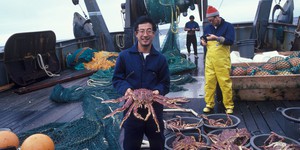Abstract
The oceans are a precious natural resource, part of Earth's carbon cycle. But what happens if the oceans absorb too much carbon dioxide? Many scientists are concerned that the increased absorption of carbon dioxide is causing them to become more acidic. What impact does that have on the marine life? In this ocean science fair project, you will demonstrate ocean acidification and investigate the effect on the shells of marine life.Summary
Michelle Maranowski, PhD, Science Buddies
The author would like to thank Dr. Vicky Fabry (California State University, San Marcos) for the experimental procedure and helpful discussion, and Mr. Robert Monroe of the Scripps Institute, San Diego, California.
- Instant Ocean® is a registered trademark of Spectrum Brands, Inc.
Objective
To understand and demonstrate ocean acidification.
Introduction
Many scientists around the world are concerned with global warming and climate change. Global warming is defined as the increase in the average measured temperature of the air and ocean layers closest to Earth's surface. Climate change is defined as any long-term significant change to the average weather that a given region experiences. The causes of warming remain an active area of research. However, one theory is that present global warming is due, in part, to an increase in anthropogenic greenhouse gases, such as carbon dioxide (CO2), since the start of the industrial revolution.
Earth is protected and kept warm by our atmosphere, which is made up of several layers. Visible sunlight penetrates easily through the atmosphere and warms Earth's surface. Earth's surface then emits invisible infrared radiation back. As the radiation moves up, layer by layer, through the atmosphere, some is absorbed by each layer. Each layer of air sends some of the energy it has absorbed back toward Earth, and some upward to higher layers. As you go higher, the atmosphere gets thinner and colder. Eventually, the energy reaches a layer so thin that radiation can escape into space. Adding more carbon dioxide to a layer allows that layer to absorb more radiation or heat energy. So the layers from which most of the heat energy used to leave Earth become warmer, sending more of the heat energy back to Earth. This means that the energy can't leave Earth until it reaches even higher, thinner, layers, which are colder and therefore cannot send as much heat back to the Earth. The planet, as a whole, then takes in more energy than it emits, meaning it gets warmer.
One mechanism that has prevented some of the CO2 from entering the atmosphere is our oceans. Oceans absorb approximately one-third of the anthropogenic CO2. However, this comes at an ecological cost—a phenomenon called ocean acidification. As CO2 dissolves in seawater, the pH of the water decreases. The pH is a measure of the amount of hydrogen ions or activity in a solution. As the pH decreases, the water becomes more acidic.
When CO2 dissolves in seawater, it forms carbonic acid. This reaction is shown in Equation 1.
Equation 1:
| CO2 + H2O ↔ H2CO3 (carbonic acid) |
|
Some of the carbonic acid dissociates in water, releasing hydrogen ions and bicarbonate. This is shown in Equation 2.
Equation 2:
| H2CO3 ↔ H+ + HCO3- |
|
The hydrogen ions have two effects. Some of them stay in the ocean water increasing the overall pH of the ocean. Others react with carbonate ions already present in the water to make bicarbonate. This process removes carbonate ions from the water. Organisms such as coral, mussels, and clams use carbonate ions and calcium to make their shells or skeletons. If the amount of carbonate is reduced, then it is harder for these organisms to flourish. Equation 3 shows how hydrogen ions and carbonate combine to create bicarbonate.
Equation 3:
| H+ + CO32- ↔ HCO3- |
|
The oceans naturally take up atmospheric CO2, about 7 billion metric tons per year. The oceans absorb CO2 at the surface and transfer it to the deep waters, out of contact with the atmosphere for centuries. Prior to the industrial revolution, ocean and atmosphere CO2 concentrations were in balance. But elevated atmospheric CO2 levels, caused by the burning of fossil fuels, have forced excess CO2 into the surface waters of the ocean. This fossil fuel CO2 gas invasion into the surface waters of the ocean is now proceeding at about 1 million tons of CO2 per hour. The oceans are more acidic now than they have been in at least 650,000 years.
Acidified water can also lead to acidosis in higher marine life forms. Acidosis is an increase in carbonic acid in the body fluids, causing lower pH values in blood. This can lead to a whole host of health issues in these organisms.
In this ocean science fair project, you will demonstrate ocean acidification. You will make seawater and add varying amounts of vinegar (acetic acid) to change the pH and see how this affects empty mussel shells. This project takes about a month of testing, so plan ahead, but don't let this discourage you from being part of the climate change and global warming debate!
Terms and Concepts
- Global warming
- Anthropogenic
- Greenhouse gas
- Infrared radiation
- Ocean acidification
- pH
- Ion
- Carbonic acid
- Dissociation
- Carbonate
- Bicarbonate
- Fossil fuel
- Acidosis
- Aragonite
Questions
- What makes a solution acidic?
- How would you describe ocean acidification?
- What are some of the effects of lower pH water on marine organisms?
Bibliography
- Feely, R. (2008, June 5). Hearing on Ocean Acidification. Retrieved November 19, 2008.
- Wikipedia Contributors. (2008, November 12). Ocean acidification. Wikipedia: The Free Encyclopedia. Retrieved November 20, 2008.
- McFarling, U.L. (2006, August 3). A Chemical Imbalance. Los Angeles Times. Retrieved November 24, 2008.
The following website contains a myriad of information on ocean acidification.
- The Ocean Acidification Network. (n.d.). Ocean Acidification. Retrieved November 19, 2008.
Materials and Equipment
- pH meter; available from an online supplier such as Carolina Biological catalog #186000.
- Calibration liquids; available from an online supplier such as Carolina Biological catalog #185740.
- Mussel shells (6 oz.); the best method is to find shells at the beach, or you can go to your local grocery store and ask the fishmonger for their dead mussels. Store them in the refrigerator until you are ready to use them.
- Bucket
- Filtered tap water
- Optional, if you are using unfiltered tap water: Dechlorinator; water dechlorinator can be purchased from a store that carries aquarium and fish supplies.
- Instant Ocean® salt; available at pet stores or from an online supplier such as Carolina Biological catalog #671440.
- Wooden spoon
- Dry measuring cup, 1/4-cup
- Sealable sandwich baggies
- Hammer
- Digital scale. Use a scale with the finest resolution that you can find. You could ask to borrow one from your school chemistry lab.
- Digital camera
- Paper towels (1 roll)
- Glass jars with lids, clean and should hold at least a pint (~ 0.5 L) of liquid (6)
- Permanent marker
- Labels
- White distilled vinegar (acetic acid)
- Eye dropper
- Sieve, fine mesh
- Lab notebook
Disclaimer: Science Buddies participates in affiliate programs with Home Science Tools, Amazon.com, Carolina Biological, and Jameco Electronics. Proceeds from the affiliate programs help support Science Buddies, a 501(c)(3) public charity, and keep our resources free for everyone. Our top priority is student learning. If you have any comments (positive or negative) related to purchases you've made for science projects from recommendations on our site, please let us know. Write to us at scibuddy@sciencebuddies.org.
Experimental Procedure
Preparing the Seawater
- To start this science fair project, you should open the pH meter, and following the enclosed instructions, calibrate it with the calibration liquids.
- Prepare the shells. Remove and discard any flesh. Wash the shells in tap water and dry them thoroughly. Set them aside.
- Filtered tap water should have no chlorine in it. However, if you are using unfiltered tap water, you should use dechlorinator mixed with the tap water to get the right kind of water. Follow the instructions on side of the dechlorinator bottle.
- Following the instructions on the side of the Instant Ocean box, mix the recommended amount of Instant Ocean salt and filtered tap water in the bucket. Mix vigorously with the wooden spoon until all of the salt has dissolved into the liquid. This mixture is your seawater. Make enough seawater to fill the six jars up to the rim, but do not fill the jars just yet. Measure the pH of the seawater with the pH meter. The pH of the solution should be about 8.1, as this is the current pH of the oceans. If your reading is not 8.1, adjust the solution with more filtered tap water or more Instant Ocean salt. Set the solution aside.
Making the Control Seawater Jars
- Place a paper towel on the digital scale. Measure 1 oz. of shells on the scale. Place the shells into a sealable baggie and put on your safety goggles. Using the hammer, lightly crush the shells. The lightly crushed shells should be about the size of a U.S. quarter coin. Empty the shell fragments back onto the scale and reweigh. Record this reading in your lab notebook. Take a digital photograph of the shell fragments to record the appearance. Mount the photograph in your lab notebook or keep them for your display board.
- Place the shell fragments into one of the clean glass jars. Cover the shells with seawater. Fill the jar until it is completely full to the rim. Close the jar with the lid. Label the jar with the date, the pH of the solution, and the weight of the shell fragments. This jar is a control sample. Important Note: Make sure that the jar is completely full and that there is no space between the solution level and the lid. If there is space, then CO2 could escape out of the solution and the experiment will be inconclusive.
- Repeat steps 1–2 of this section two additional times with a new sealable baggie and jar for each set of shells.
Making the Acidified Seawater Jars
- Place a paper towel on the digital scale. Measure 1 oz. of shells on the scale. Place the shells into a baggie and put on your safety goggles. Using the hammer, lightly crush the shells. The lightly crushed shells should be about the size of a U.S. quarter coin. Empty the shell fragments back onto the scale and reweigh. Record this reading in your lab notebook. Take a digital photograph of the shells fragments to record the appearance. Mount the photograph in your lab notebook or keep it for your display board.
- Place the shell fragments into one of the clean glass jars. Cover the shells with seawater, as in the previous section, but only fill the jar until it is almost full. Using the eyedropper, put in three drops of vinegar into the jar and mix. Wait for a few minutes and then measure the pH of the solution with the pH meter. If you'd like to read more about how to use a pH meter, visit the Science Buddies Chemisty Lab Techniques page.
- The pH of the solution should be about 7.5. This is the projected pH of the oceans in the year 2100 if the levels of anthropogenic CO2 continue as they are now (The Ocean Acidification Network).
- If the pH is not 7.5, add more vinegar (if the solution is not acidic enough) or more seawater (if the solution is too acidic).
- Make sure that the jar is completely full and that there is no space between the solution level and the lid. If there is space, then CO2 could escape out of the solution and the experiment will be inconclusive.
- Place the lid on the jar and label the jar with the date, the pH of the solution, and the weight of the shell fragments.
- Repeat steps 1–2, of this section, two additional times. You should now have three control jars and three acidified seawater jars, all with shell fragments in them.
- Place the six jars in a spot where they will not be disturbed. Leave them in this location for 1 month. Do not open the jars during the month or the pH of the solutions will change.
Evaluating Your Results
- Open the jars at the end of one month. Open and drain the jars, one at a time, by carefully emptying them through a sieve over a sink. Make sure not to lose any of the shell fragments. Rinse the shell fragments from each jar in filtered tap water and dry them thoroughly with paper towels.
- Place a paper towel on the scale and turn it on. Weigh the shell fragments from each jar. Be sure to keep track of which jar the shell fragments came from in your lab notebook. Record the data in your lab notebook.
- Compare the present appearance of the shell fragments to the photograph of the shell fragments prior to the experiment. Is there a difference? Record this information in your lab notebook. Take new pictures for your lab notebook or display board.
- Repeat steps 1–3, of this section, for all of the jars. Record all of the data in your lab notebook.
- Plot the data on a scatter plot. Is there a difference in the weight of the shell fragments that spent a month in the acidified seawater and the shells that were in plain seawater? What is the percentage change in weight?
Ask an Expert
Global Connections
The United Nations Sustainable Development Goals (UNSDGs) are a blueprint to achieve a better and more sustainable future for all.
Variations
- You can accelerate the test by reducing the pH beyond 7.5. How does reducing the pH beyond 7.5 change the final weight of the shells?
- Repeat the experiment with different kinds of shells. For example, if you originally used mussel shells, try using clam shells in your second round of testing.
- See how temperature and pH affect the shells. Place a jar with acidified seawater and shells in the refrigerator. Keep it in the refrigerator for a month. How does lower temperature affect the end weight of the shell fragments?
Careers
If you like this project, you might enjoy exploring these related careers:
Related Links
- Science Fair Project Guide
- Other Ideas Like This
- Ocean Sciences Project Ideas
- My Favorites
- Acids, Bases, & the pH Scale
- Chemistry Lab Techniques












